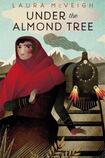
One of Ireland's best loved children's books comes to mind when reading this week's choice for new fiction. Marita Conlon McKenna's Under the Hawthorn Tree (1990), the first in a trilogy of famine novels, sees three siblings trek across a blight-ridden Ireland in the hope of finding family. With a title that pays homage to Conlon McKenna, Under the Almond Tree also tells of a dangerous journey undertaken by a young adult narrator seeking shelter in desperate times.
In Laura McVeigh's debut, 15-year-old Samar and her family are refugees, fleeing the conflict in Afghanistan in the 1990s, after attacks from the Russians and then the Taliban make life in Kabul untenable. The author looks at the catastrophic effects of war and displacement on a liberal, middle-class family whose home town becomes "a tinderbox and us oblivious".
Growing up in Northern Ireland in the 1980s, McVeigh studied modern and medieval languages at Cambridge before becoming director of Pen International, a role that saw her travel widely and work with people seeking refuge and campaigning for freedom of expression.
Didactic
In an author’s note at the end of the novel, which may be instructive for a younger audience but feels didactic, McVeigh explains that she has witnessed the stories of families separated or forced to leave their homes. What interests her is the capacity of individuals to carry on, a quality that the brave and imaginative Samar has in abundance. Her incredible tale takes in so many momentous events that it stretches credibility for adult historical fiction, though it nonetheless provides an adventure-filled and educational look at a conflict that has dominated the Middle East for decades.
There are lessons in everything from the Decembrist uprising in imperial Russia, to Ahmad Massoud's Northern Alliance in Afghanistan, the move from the tolerant Kabul of the 1970s to the hardline morality of the Taliban, and, most poignantly, the displacement or death of hundreds of thousands of people caught in the crossfire of multiple, seemingly endless wars. In the hands of a young, omniscient narrator, the sorrowful story is humanised and never preachy.
When we first meet Samar she is on the Trans-Siberian Railway with her parents and numerous siblings, apparently going back and forth in a perpetual journey between Asia and Europe until the family either runs out of money or decides on a plan for safety. It is a neat conceit that highlights the limited choices available to refugees, even those with money. It also affords Samar plenty of time to write her story, encouraged by the train's provodnik Napoleon, whose own past as the son of an NKVD guard forms an interesting subplot.
Characters
A long list of characters at the start of the book – rarely a good idea unless you’re writing
War and Peace
, as noted recently by
John Boyne
in this paper – is unnecessary as the vividly drawn family members come to life through their beliefs and actions. There’s the older brother Omar who runs off to join the Alliance, mild-tempered Javad who utterly changes after indoctrination by the Taliban, beautiful elder sister Ara – “too old to play in the dirt, not yet old enough to be shut away indoors” – and Samar’s politically involved parents who lead an outwardly happy life in a yellow house in Kabul owned by their friend Arsalan. A back story involving these older characters and the titular almond tree is somewhat clunky and never fully resolved. Samar is more engaging when narrating her own astonishing journey from Kabul to the mountains to live with her grandparents, then on to a grimly realised refugee camp and finally her trek from the camps through Afghanistan into
Tajikistan
, the Kyrgyz Republic and Russia.
So much happens that the story can be fleeting at times, with the impetus definitely on action rather than reflection. McVeigh is vivid on the violence of camp life, for example, but there is little interior realism on all the loss experienced. An attempt at intertextuality with Anna Karenina adds little despite the references to train stations towards the end.
Paint-by-numbers
The tragic characters that Samar encounters on her travels – the boy in the cave, the villainous Alliance soldier, the injustice meted to the widower Nazarine and her daughter – give a paint-by-numbers feel to the conflict, but their stories are nevertheless memorable. The world of the Middle East comes brilliantly to life through McVeigh’s peppering of foreign phrases, from food to nature to “buzul-bazi”, a children’s game played with sheep knucklebones.
As Samar depicts the ruined lives of so many characters, the importance of storytelling is at the core of the novel. The power of the imagination to sustain unbearable tragedy is weaved throughout. Just as the hawthorn tree symbolised the otherworld that loomed over Conlon McKenna’s young siblings, the almond tree of McVeigh’s book is also a symbol, one of hope that stories can ultimately act as saviours.
















